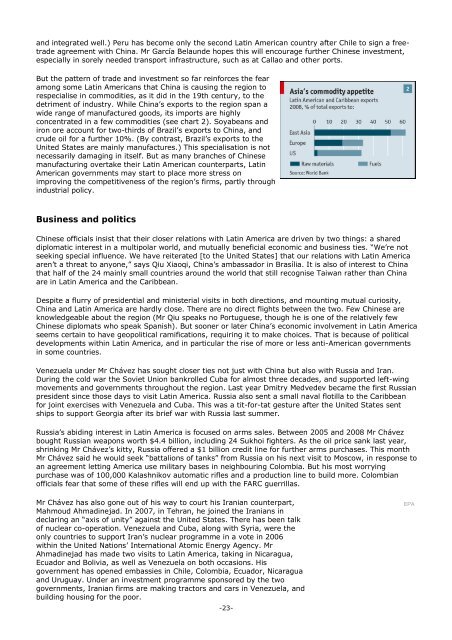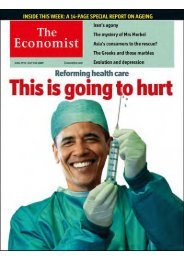Untitled - the ultimate blog
Untitled - the ultimate blog
Untitled - the ultimate blog
You also want an ePaper? Increase the reach of your titles
YUMPU automatically turns print PDFs into web optimized ePapers that Google loves.
and integrated well.) Peru has become only <strong>the</strong> second Latin American country after Chile to sign a freetrade<br />
agreement with China. Mr García Belaunde hopes this will encourage fur<strong>the</strong>r Chinese investment,<br />
especially in sorely needed transport infrastructure, such as at Callao and o<strong>the</strong>r ports.<br />
But <strong>the</strong> pattern of trade and investment so far reinforces <strong>the</strong> fear<br />
among some Latin Americans that China is causing <strong>the</strong> region to<br />
respecialise in commodities, as it did in <strong>the</strong> 19th century, to <strong>the</strong><br />
detriment of industry. While China’s exports to <strong>the</strong> region span a<br />
wide range of manufactured goods, its imports are highly<br />
concentrated in a few commodities (see chart 2). Soyabeans and<br />
iron ore account for two-thirds of Brazil’s exports to China, and<br />
crude oil for a fur<strong>the</strong>r 10%. (By contrast, Brazil’s exports to <strong>the</strong><br />
United States are mainly manufactures.) This specialisation is not<br />
necessarily damaging in itself. But as many branches of Chinese<br />
manufacturing overtake <strong>the</strong>ir Latin American counterparts, Latin<br />
American governments may start to place more stress on<br />
improving <strong>the</strong> competitiveness of <strong>the</strong> region’s firms, partly through<br />
industrial policy.<br />
Business and politics<br />
Chinese officials insist that <strong>the</strong>ir closer relations with Latin America are driven by two things: a shared<br />
diplomatic interest in a multipolar world, and mutually beneficial economic and business ties. “We’re not<br />
seeking special influence. We have reiterated [to <strong>the</strong> United States] that our relations with Latin America<br />
aren’t a threat to anyone,” says Qiu Xiaoqi, China’s ambassador in Brasília. It is also of interest to China<br />
that half of <strong>the</strong> 24 mainly small countries around <strong>the</strong> world that still recognise Taiwan ra<strong>the</strong>r than China<br />
are in Latin America and <strong>the</strong> Caribbean.<br />
Despite a flurry of presidential and ministerial visits in both directions, and mounting mutual curiosity,<br />
China and Latin America are hardly close. There are no direct flights between <strong>the</strong> two. Few Chinese are<br />
knowledgeable about <strong>the</strong> region (Mr Qiu speaks no Portuguese, though he is one of <strong>the</strong> relatively few<br />
Chinese diplomats who speak Spanish). But sooner or later China’s economic involvement in Latin America<br />
seems certain to have geopolitical ramifications, requiring it to make choices. That is because of political<br />
developments within Latin America, and in particular <strong>the</strong> rise of more or less anti-American governments<br />
in some countries.<br />
Venezuela under Mr Chávez has sought closer ties not just with China but also with Russia and Iran.<br />
During <strong>the</strong> cold war <strong>the</strong> Soviet Union bankrolled Cuba for almost three decades, and supported left-wing<br />
movements and governments throughout <strong>the</strong> region. Last year Dmitry Medvedev became <strong>the</strong> first Russian<br />
president since those days to visit Latin America. Russia also sent a small naval flotilla to <strong>the</strong> Caribbean<br />
for joint exercises with Venezuela and Cuba. This was a tit-for-tat gesture after <strong>the</strong> United States sent<br />
ships to support Georgia after its brief war with Russia last summer.<br />
Russia’s abiding interest in Latin America is focused on arms sales. Between 2005 and 2008 Mr Chávez<br />
bought Russian weapons worth $4.4 billion, including 24 Sukhoi fighters. As <strong>the</strong> oil price sank last year,<br />
shrinking Mr Chávez’s kitty, Russia offered a $1 billion credit line for fur<strong>the</strong>r arms purchases. This month<br />
Mr Chávez said he would seek “battalions of tanks” from Russia on his next visit to Moscow, in response to<br />
an agreement letting America use military bases in neighbouring Colombia. But his most worrying<br />
purchase was of 100,000 Kalashnikov automatic rifles and a production line to build more. Colombian<br />
officials fear that some of <strong>the</strong>se rifles will end up with <strong>the</strong> FARC guerrillas.<br />
Mr Chávez has also gone out of his way to court his Iranian counterpart,<br />
Mahmoud Ahmadinejad. In 2007, in Tehran, he joined <strong>the</strong> Iranians in<br />
declaring an “axis of unity” against <strong>the</strong> United States. There has been talk<br />
of nuclear co-operation. Venezuela and Cuba, along with Syria, were <strong>the</strong><br />
only countries to support Iran’s nuclear programme in a vote in 2006<br />
within <strong>the</strong> United Nations’ International Atomic Energy Agency. Mr<br />
Ahmadinejad has made two visits to Latin America, taking in Nicaragua,<br />
Ecuador and Bolivia, as well as Venezuela on both occasions. His<br />
government has opened embassies in Chile, Colombia, Ecuador, Nicaragua<br />
and Uruguay. Under an investment programme sponsored by <strong>the</strong> two<br />
governments, Iranian firms are making tractors and cars in Venezuela, and<br />
building housing for <strong>the</strong> poor.<br />
-23-<br />
EPA








![[ccebbook.cn]The Economist August 1st 2009 - the ultimate blog](https://img.yumpu.com/28183607/1/190x252/ccebbookcnthe-economist-august-1st-2009-the-ultimate-blog.jpg?quality=85)



![[ccebook.cn]The World in 2010](https://img.yumpu.com/12057568/1/190x249/ccebookcnthe-world-in-2010.jpg?quality=85)
![[ccemagz.com]The Economist October 24th 2009 - the ultimate blog](https://img.yumpu.com/5191885/1/190x252/ccemagzcomthe-economist-october-24th-2009-the-ultimate-blog.jpg?quality=85)